Suomi Country Air Defense (Part 1)
The Finnish Air Force was officially formed on 4 on May 1928 of the year. At about the same time, ground-based air defense units appeared. In the 1939 year, by the beginning of the Winter War, the qualitative and quantitative composition of the Finnish Air Force was no match for the Soviet capabilities. Finnish anti-aircraft artillery was relatively modern, albeit small.
From the side of the Red Army Air Force in the company took part around 2500 aircraft, Finland in the initial period of the war could only expose 114 combat aircraft. Despite the fact that the superiority of the USSR in the air was overwhelming, the Finns were able to offer stubborn resistance. In this they were assisted by many countries that supplied combat aircraft. Also in the Finnish Air Force many foreign volunteer pilots fought.
The main fighter of the Finnish Air Force in the initial period of the war was the Fokker D.XXI. This aircraft, which made its first flight in the 1936 year, was specifically designed to protect the Dutch colonies in Asia. Fighter with Mercury VIII air-cooled engine with 830 horsepower. developed in horizontal flight speed 460 km / h. The armament of most of the Finnish fighter of this type consisted of four 7,92 mm machine guns M36 FN-Browning.
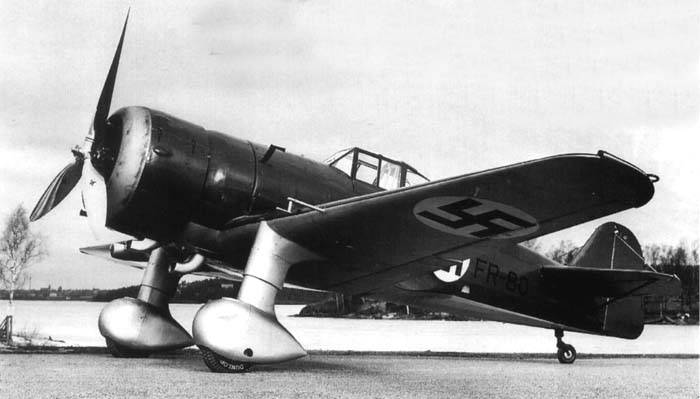
According to the reference data, at the time of the outbreak of hostilities, the Fokker 41 was at the disposal of the Finns. These fighters, despite the relatively weak weapons, performed well in battles. Thus, according to Finnish sources, 6 January 1940, a pair of Fokkers in one air battle shot down 7 bomber DB-3, flying without fighter cover. Of course, to imagine this is very difficult, according to Western historians, there was no defensive armament on Soviet bomber. Fokkers were mainly used as part of the 24 th air group (LLv-24). Until the end of hostilities in March 1940, this unit lost its 12 fighter. 22 "Fokker" was in the ranks, still 4 machines were being repaired.
The Finnish command forbade their pilots to absolutely get involved in an air battle with Soviet fighters, since the latest series of X-NUMXs exceeded Dutch-made fighters in speed and armament. Yes, and it would seem that the obsolete I-16 bis and I-15 were a difficult opponent. Experienced pilots flying on Polikarpov’s biplanes quickly got on the tails of the Fokkers on turns. However, the Fokker D.XXI was operated by the Finnish Air Force until the beginning of the 153s.
In addition to the Fokker D.XXI, at the beginning of the conflict in the country of Suomi, there were 15 biplanes of British-made Bristol Bulldog Mk. IVA. The Bulldog, which went into series in 1930, is definitely outdated by 1939.
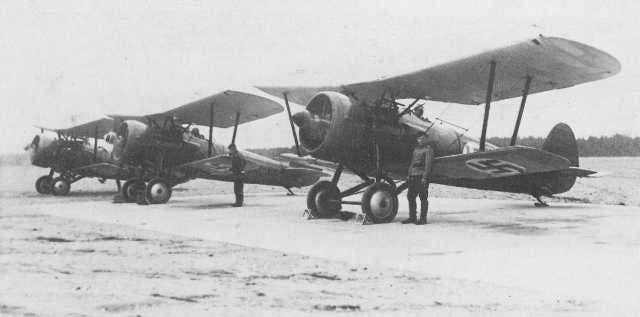
Fighter with maximum take-off weight 1590 kg and air-cooled Bristol Jupiter engine with 440 horsepower. developed 287 km / h. Armament consisted of two machine guns caliber 7,7 mm.
Despite the modest flight data, the pilots flying the Bulldogs managed to shoot down much more modern machines. According to Finnish data again, the Bulldogs won 6 victories, losing one of their fighters. Among the planes shot down by them are SB and I-16. Nevertheless, the chances of these fighters in air combat were few, and they were used mainly for training purposes.
After the armed conflict with the USSR entered into an active phase, many states provided military assistance to Finland. For example, the UK government has authorized the delivery of Gloster Gladiator Mk II fighter 30, the French have sent the same number of Morane-Solnier MS406, Italy 10 Fiat G.50. The largest batch of fighters was supplied by the United States - 44 Brewster 239.
As for the English fighter "Gloucester Gladiator", this biplane had become obsolete by the time it was put into service in 1937. The last fighter of the RAF biplane scheme at an altitude of 4000 meters could reach 407 km / h. Armament - 4 machine gun caliber 7,7 mm. Despite the fact that the chassis was non-retractable, the pilot was sitting in a closed cockpit. This was important when operating in negative temperatures.
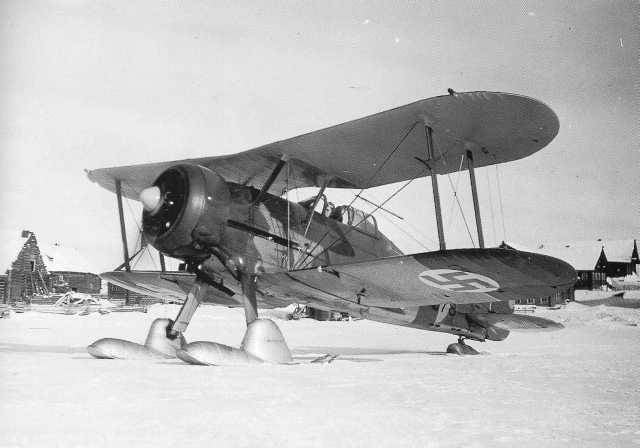
The main part of the "Gladiators" was supplied from England, but as it became known later, the Swedish Air Force fighters carrying Finnish insignia took part in the Winter War. They were ruled by the Swedes, who were professional soldiers who went to fight as volunteers. Swedish "Gladiators" shot down eight Soviet aircraft.
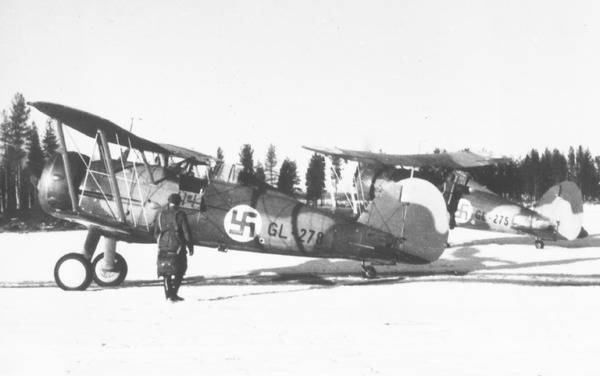
The first combat flight on the "Gladiator" took place on 2 February 1940 of the year. Fighters of this type performed well in battles. Their pilots claim 45 air victories with the loss of 12 machines. The use of the “Gladiators” in the Finnish Air Force for combat purposes continued until the 1943 year. The last airborne victory of this type of fighter was won on 15 in February of 1943, when Lieutenant Hakan Stromberg shot down his communications unit P-5 during reconnaissance along the Murmansk railway.
Compared to the British Gloster Gladiator, the French Morane-Solnier MS406 seemed like a plane of another generation. In part, this was the case, although these fighters appeared almost simultaneously.
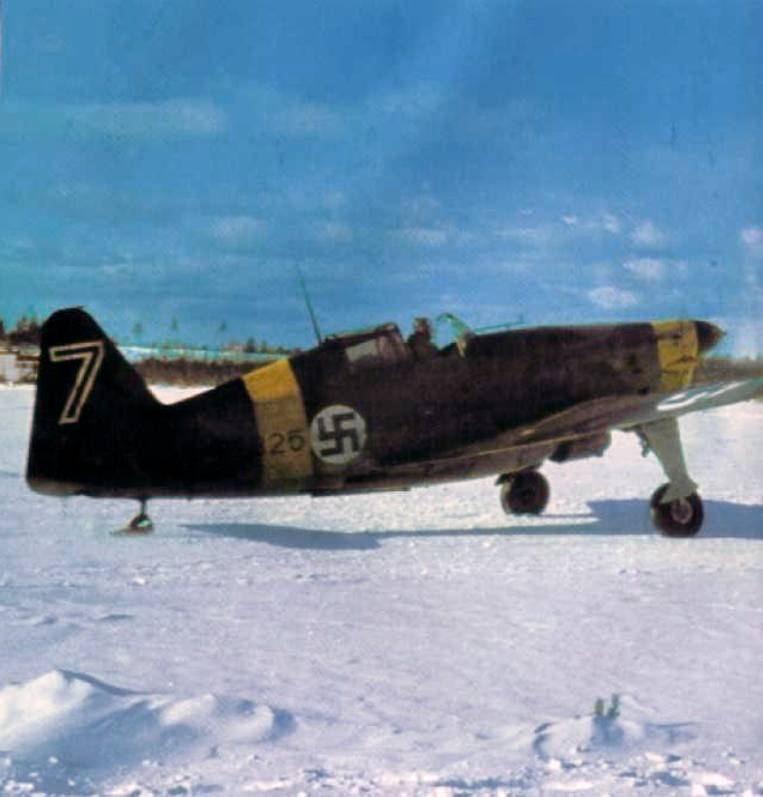
It was a low-wing monoplane with a retractable landing gear and a Hispano-Suiza 12Y-31 HP liquid-cooled engine powered by an HP 860. At an altitude of 5000 meters, Moran developed 486 km / h. The fighter had a very powerful weapon for the end of 30-s - 20 mm Hispano-Suiza HS.404 cannon and two 7,5 mm MAC 1934 machine guns. In capable hands, these fighters were a great threat. According to Western data, during the Winter War, the Morans made 259 combat missions, shooting down Soviet aircraft 16.
After the fall of France, the Nazis handed over the captured "Morans" and spare parts to the Finns. Since the French aircraft could no longer be on an equal footing with the Soviet fighters of new types, they tried to modernize them in Finland. At the beginning of 1943, Moran installed a captured M-105 engine with a power of 1100 hp, a new bonnet and an adjustable screw. The speed increased to 525 km / h. The composition of armaments has changed: now in the collapse of the engine cylinders, the German 15 and 20 mm MG submachine gun MG 151 / 20 and 12,7 mm were mounted by the Soviet BS machine guns. This variant is known in Finland as “Lagg-Moran”. However, due to the lack of engines, it was not possible to carry out the re-engineization of all the Morans. Fighters actively participated in the battles, Finnish pilots who flew the Moranah claim 118 shot down Soviet aircraft with the loss of their vehicles 15. At the time of the end of hostilities, the 41 aircraft was in service, which were used for training purposes until the 1952 year.
At the end of the 1939 of the year, even before the outbreak of hostilities, Finland ordered the Italian fighters 35 Fiat G.50. The first 10 aircraft were to be delivered before February 1940, and a group of Finnish pilots completed the 10-hour training course at the factory Fiat Aviazione airfield in Turin.
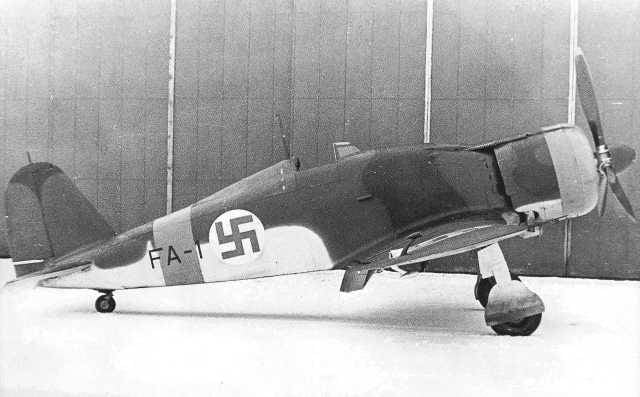
The Fiat G.50, put into service in the 1938 year, was the first production Italian monoplane fighter with a retractable landing gear. Star-shaped 14-cylinder air-cooled engine Fiat A.74 RC38 with HP 870 power at an altitude of 3000 meters, I clocked the Fiat to 472 km / h. Armament consisted of two machine guns Breda-Safat 12,7 caliber mm.
Despite the accelerated training of the flight and technical staff and the forced delivery, Italian-made fighters did not really have time to take part in the Winter War. Observers celebrated Fiat combat missions in the Vyborg region in February-March 1940. At the very beginning of operation, at least two fighters were defeated due to insufficient pilot qualifications. The Utti home base has been bombed several times, and it was too dangerous to be there. Therefore, the fighters relocated to the ice of Lake Vesijärvi.
The Fiats, set in 1940, had an open cockpit, which did not add to their popularity when flying in winter. Nevertheless, the pilots announced 18 shot down Soviet aircraft. These were mainly SB and DB-3 bombers and I-153 biplanes. Data on their own losses vary, most often it is said that the Finnish Air Force lost five "Fiat". How many of them died in air battles, is not known.
Fiat's finest hour came in the summer of 1941, when the pilots of these fighters showed the highest percentage of victories in the Finnish Air Force, announcing 52 victories with the loss of only one of their aircraft by the end of the year. In total, from February 1940 to September 1944, according to official Finnish data, G.50 pilots shot down 99 enemy planes. As can be seen, the main part of the Finns air victories fell on the most difficult period for the USSR. As Soviet pilots acquired combat experience and new aviation types of combat aircraft entered the combat regiment, the successes of the Finnish Air Force declined sharply. Already in 1942, Fiat G.50 could not compete on equal terms with the Soviet Yak and Lugg, and by 1944, this gap had widened even more. But due to the shortage of combat aircraft, despite the strong wear and tear, the Fiat 10-12 flew into the air until a truce with the Soviet Union was reached. Unlike the French Morane-Solnier MS406, no attempt was made to modernize the Fiat G.50. The last fighter of this type was officially written off in the first half of 1946.
American-made fighter jets Brewster 239 were the most numerous type ordered by the Finns during the Winter War. A contract worth $ 3,4 million was concluded with the United States 16 December 1939. In addition to 44 fighters, the Americans pledged to supply spare engines, a set of spare parts and weapons. Since in the USA these vehicles were originally intended for basing on aircraft carriers, special take-off devices and life-rafts were removed from the fighter jets, which somewhat reduced the take-off weight.

The aircraft, known in the US Navy as the Brewster F2A Buffalo, was put into service in the 1939 year. It was one of the first American monoplane fighter with a retractable landing gear. The modification with a nine-cylinder engine of air cooling Wright R-1820-G5 Cyclone with power 950 hp was delivered to Finland. The plane with a take-off weight of 2640 kg, at an altitude of 4700 meters, developed a speed of 478 km / h. The armament was powerful enough - the 4 large-caliber 12,7 mm machine gun M2 Browning. For that time, the Buffalo was one of the most powerful fighters.
The first Brewsters arrived in Finland in February 1940. The assembly of the aircraft, delivered by sea to Norway, and then by rail to Sweden, was carried out at the enterprise SAAB in Gothenburg. The first five fighters reached combat readiness before the end of the war, but did not take part in the hostilities. The fighters additionally installed bronspinki and sights of Finnish production.
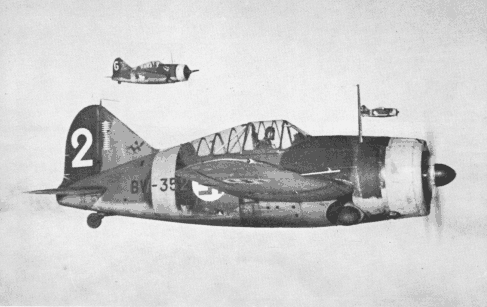
The first baptism of the Brewster took place on 25 on June 1941. According to Finnish sources, on that day a pair of fighters engaged the 27 bombers of the Security Council over Turku and allegedly shot down the 5 of Soviet aircraft, without incurring losses. In general, in the Finnish Air Force this type of fighter is considered perhaps the most successful. He was appreciated not only for good flight data, but also for reliability. Initially, there were problems with the reliability of the engines, but the Finnish mechanics managed to fix all the problems. The disadvantage of the fighter was considered to be unprotected fuel tanks, in addition, in some cases the Brewster was confused with the Soviet I-16. During the war in Finland, an attempt was made to copy the Brewster 239, but the work was delayed, and as a result, after the start of deliveries in the German 1943, the German Messerschmitt Bf 109G closed this topic.
According to the Finns, in three years from 25 on June 1941 of the year, to 17 on June 1944 of the year, pilots of the 24 of the fighter air group flying on the Brewster shot down 477 of Soviet aircraft, having lost their machines in 19. After Finland signed an armistice with the Soviet Union in September 1944, Finnish fighters rose to intercept German aircraft. So, on October 3, 1944 of the year was shot down by Ju 87, which invaded Finnish airspace, but such cases were sporadic. Brewster 239 active service in the Finnish Air Force continued until September 1948. The latest aircraft were scrapped in 1953.
At the beginning of 1940, Finland purchased Hawker Hurricane Mk I British 12 fighters. However, they failed to take part in the Winter War. Moreover, only ten cars reached Finland: two planes were lost during the haul.
The fact that the British government, which is in a state of war with Germany, despite the acute need for modern fighters, has sanctioned the sale of combat aircraft, indicates the intention to drag the USSR into a protracted military conflict.
For its time, the Hurricane was fairly high flight data, its mass production began at the end of the 1937 of the year. Hawker Hurricane Mk I was equipped with a Rolls-Royce Merlin II engine with a capacity of 1030 l. with. Maximum speed - 540 km / h. Armament - eight 7,7 mm machine guns Browning .303 Mk II.
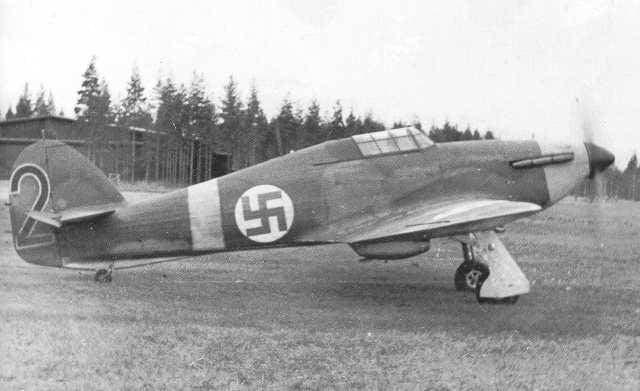
The Finnish Hurricanes entered the battle at the end of June 1941, but were used in a rather limited manner during the fighting, due to the lack of spare parts. In the spring of 1942, a replenishment was received in the form of a trophy Soviet Hurricane Mk II. This February 1942 aircraft made an emergency landing on Topozer’s ice and was rebuilt. Two other Soviet Hurricane, which flopped on the belly in the Finnish rear, were used as donors.
In the 1943 year, the Hurricane flights virtually ceased, although they were listed in the Finnish Air Force. According to Finnish data, on account of these fighters 5 air victories. Five Finnish "Hurricanes" were lost in aerial combat, two more were victims of Soviet anti-aircraft artillery. The last time the Hurricane of the Finnish Air Force flew into the air on 31 May 1944.
According to Western historians, during the Winter War, on the territory controlled by Finnish troops, they made an emergency landing of 25 Soviet aircraft. It was possible to return 5 I-15 bis, 8 I-153 and 1 I-16 to the flight state. There is no information that these vehicles made combat missions. Most likely, they were used for training purposes and for the organization of training air battles. Repair of trophy aircraft was carried out at the State Aviation Enterprise Valtion lentokonetehdas. Engines and other parts were taken from aircraft, the restoration of which was considered impractical.
As can be seen from the foregoing, during the armed confrontation with the USSR in the winter of 1939-1940. The Finnish Air Force remained operational only through foreign supplies. On the Finnish side, during the Winter War, pilots from England, Poland, USA, Sweden, Norway, Denmark and Italy fought. According to Western data, 225 combat aircraft were delivered from abroad to Finland during the Winter War. At the same time, fighters and bombers of the Air Force of “neutral” Sweden, who flew during the conflict with the Finnish identification marks, were not included in this number, because after the end of the war they returned home with the crews. Thanks to foreign military assistance, the Finnish Air Force 1 of April 1940 of the year, despite the losses, numbered 196 combat aircraft, that is, more than before the start of the conflict. The same applies to the supply of aviation gasoline and oil, fuel and lubricants for combat aircraft delivered mainly from Sweden.
According to Finnish data, 493 Soviet planes were shot down in 293 air battles, while Finnish anti-aircraft gunners claim another 330 downed planes. The Finns admit that they lost 67 of their vehicles during the fighting. 69 aircraft were seriously damaged. In the course of the fighting, 304 Finnish airmen died, 90 went missing, 105 were wounded. But it is not known whether the losses of numerous foreign volunteers were taken into account. In turn, domestic sources cite data that are fundamentally different from Finnish ones. So, in the book of V.S. Shumikhina "Soviet military aviation 1917 - 1941 ”states that combat losses amounted to 261 aircraft and 321 aviators. Soviet aviators and anti-aircraft gunners announced the destruction of 362 enemy aircraft. Based on this, we can clearly say that the parties overestimated the enemy’s losses by more than two times.
Most foreign military observers present in Finland in the winter of 1939-1940 noted the fierce nature of aerial combat. Finnish pilots who sat in the cockpits of the few fighters compared to the Red Army's air force did everything possible to prevent Soviet bombers from accessing their own facilities. There are cases when the Finns in a desperate situation went to the ram. Soviet pilots considered the Finnish pilots a strong and very dangerous opponent. At the same time, the Finnish command tried with all its might to avoid casualties. Fighter pilots were forbidden to engage in combat with Soviet fighters without urgent need. A significant number of victories in the accounts of a number of Finnish aces is explained not only by high personal mastery, but also by the “hit and run” tactics. As well as careful planning of air battles and distribution of roles. In a number of cases, Soviet fighters, who were flattered by blithely flying and seemingly unaware single Finnish lure aircraft, were shot down by a sudden attack from the sun. The weak point of the Finnish military aviation was a large diversity, which greatly hampered the training of personnel, repair, and the supply of spare parts and ammunition.
To be continued ...
Based on:
http://www.jaegerplatoon.net/AA_GUNS2.htm
http://www.jaegerplatoon.net/AA_GUNS3.htm
http://www.jaegerplatoon.net/AA_GUNS3.htm#76ItK28
http://www.winterwar.com/forces/FINairdefence.htm
http://www.warrelics.eu/forum/finnish-militaria/hawker-hurricane-finnish-air-force-653845/
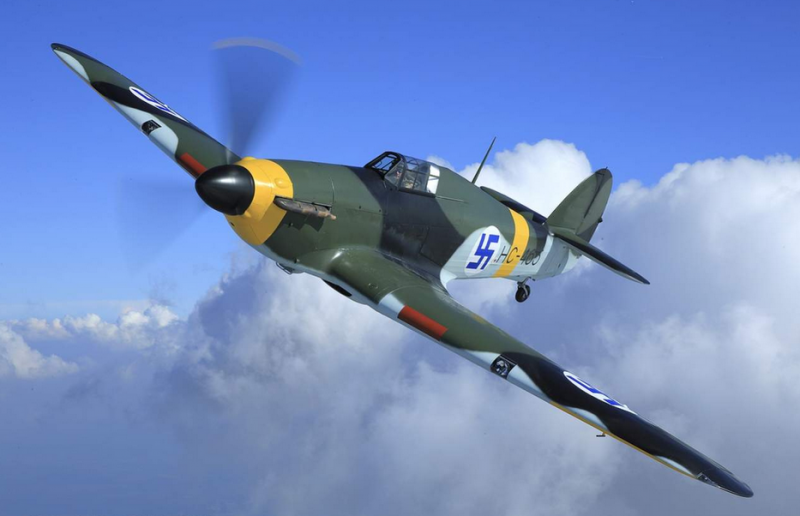
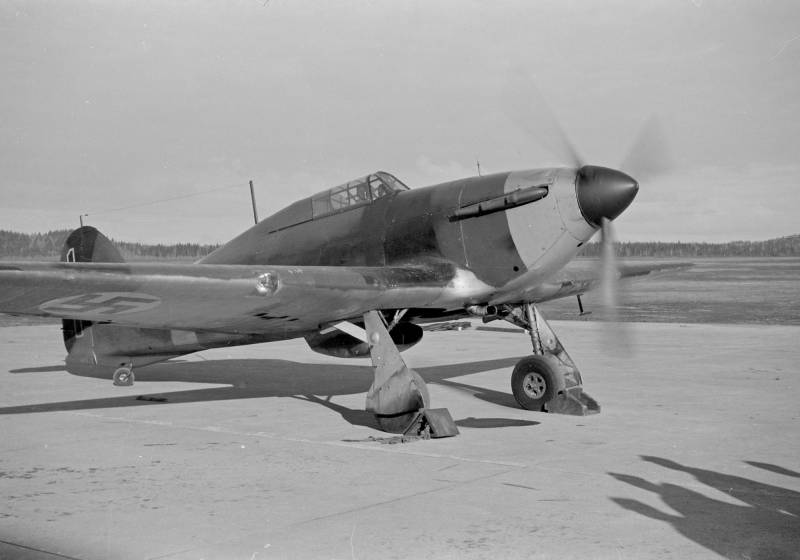
Information